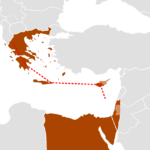Europe needs multiple gas supply sources – analysis
Reading Time: 3 minutesIncreased attention has been drawn to the eastern Mediterranean region by energy companies and European governments in recent weeks, Financial Mirror wrote in an analysis of gas supply to Europe in the aftermath of Russia’s invasion of Ukraine last February.
Despite reduced Russian gas flow due to the conflict in Ukraine, Russia continues to supply gas to several Central and Eastern Europe (CEE) countries, including Austria, Hungary and Czechia, as well as Germany and Greece.
This ongoing dependence on Russian gas highlights the difficulties in decoupling European gas imports from Moscow’s influence. Although last year Russian gas exports to Europe were significantly down year-on-year, amounting to 80.3 billion cubic metres (bcm), gas flows through Russian pipelines have continued in the first half of 2023.
Gazprom volumes down 60%
Russia’s Gazprom delivered approximately 23 bcm to European customers in the first quarter of this year, representing a 60% decrease compared to the previous year, according to recent figures from Montel.
While reduced, the continuation of Russian gas exports to the continent underscores the significant challenges Europe faces in fully cutting reliance on Russian energy, Financial Mirror commented.
A core issue lies in the long-term “pay or take” contracts that many European companies have signed with Gazprom. Seeking alternative gas supplies has become increasingly urgent in this context.
Fortunately, Europe managed to avoid severe shortages last winter due to warm weather and increased imports of liquefied natural gas (LNG).
LNG fills supply gap
European LNG imports nearly doubled in 2022 to bridge the gap resulting from the decline in Russian gas imports.
The EU imported 155.1bcm of LNG, an increase of 62 bcm year-on-year. Despite a 13% reduction in European gas consumption in 2022 due to high prices, total consumption reached 428.3bcm, accounting for 10% of global natural gas consumption and nearly 50% of North American usage.
Following the Russian invasion of Ukraine, Europe has undergone a significant shift in its gas supply pattern. The continent now competes with other regions, particularly the Asia-Pacific, for LNG gas supplies.
This competition, along with market dynamics and elevated prices, highlights the continent’s reliance on importing gas from various parts of the world after freeing itself from Russia’s grip.
Dependence inevitable in medium term
The reality is that Europe will remain dependent on substantial gas imports for the foreseeable future, as renewables and hydrogen are not yet capable of providing sufficient base load provision, has prompted EU planners to explore indigenous production options.
According to estimates by the Institute of Energy for SE Europe (IENE), Europe has the potential to tap into 12 to 14 trillion cubic metres (tcm) of gas from various proven reserves in the region, including the East Mediterranean.
Major gas discoveries have been made in the East Mediterranean, primarily off the coasts of Israel, Egypt, and Cyprus, with global energy companies holding interests in these fields.
While some gas from the East Mediterranean already reaches Europe in the form of LNG from Egypt, there is still untapped potential in the region. East Mediterranean gas could make a meaningful contribution to Europe’s energy security, although it cannot fully replace the 150bcm of Russian gas.
Multiple gas sources crucial for security
European countries are now looking for multiple sources of gas, making the East Mediterranean region significant in their diversification efforts. The crucial question remains: How much East Mediterranean gas will actually reach Europe?
According to researchers at Columbia University, the region could potentially have a surplus of 50 bcm per year by the early 2030s if field development progresses aggressively. However, the availability of this gas to Europe depends on regional governments’ prioritization of domestic demand.
Additionally, if the gas is transported as LNG, it could be sold to the highest bidder, which may not necessarily be in Europe. The “East Med” pipeline project, a €6 billion endeavor supported by the EU as a Project of Common Interest (PCI), could address this issue.
This critical project aims to transport East Mediterranean gas directly to the European market. The project is currently undergoing a market test and negotiations for financing.
Multiple gas sources, including the East Mediterranean, are essential for Europe’s energy security, Financial Mirror underlined.

